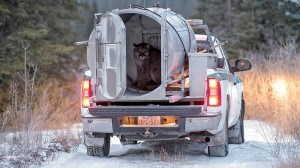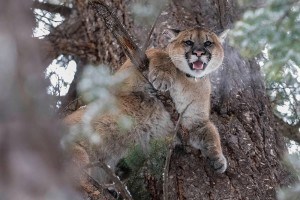
One of the great things about living with someone that works with wildlife is the stories told over dinner at the end of the day. In particular, I can tell when my husband—Parks Canada Wildlife Conflict Specialist Geoff Skinner—has been working closely with cougars, as these encounters leave him particularly reverent.
I recently got to interview him about his work with the two juvenile cougars that have made themselves known to Jasper townsfolk and trail users, and to hear first hand what it’s like to lay hands on these powerful predators.
Skinner is part of the Parks Canada human-wildlife conflict team. It has been the team’s job to monitor two young male cougars to ensure they do not become a public safety threat. The team believes the young brothers have recently left the care of their mother, who appears to occupy a territory that includes the Pyramid Bench.
Skinner explains that in addition to learning to hunt on their own, carving out a territory amongst older, stronger cats is stressful, and sometimes forces younger cats to test new, less optimal situations, such as following deer and elk into the townsite.
Since juvenile male cougars will tend to disperse long distances from their mother’s territory, the team decided to capture and radio-collar the young animals, and move them to the east part of Jasper to keep them from getting into trouble with people before they make the final cut from mommy’s apron strings.
The move brought Skinner as close to a sleeping cougar as a person can get.
“Its head kept swinging over and resting against my cheek as I attached the ropes to his front paws,” he says, as he describes how he and his colleagues carefully lowered one of the young cougars from a tree after tranquilizing him in preparation for relocation.

Both cougars were delivered safely to their new location, and, so far, although one of the young cats has moved back to the Pyramid Bench, no further encounters with people or the townsite have occurred.
In general, people rarely see cougars, though they are commonly observed on Parks Canada wildlife cameras.
As Skinner interacts with cougars and their kill sites as part of his job, he has somewhat regular stories of cougar activity in well-travelled areas in the main valley around the townsite.
For example, on one occasion in the middle of summer a few years ago, a cougar killed a bighorn sheep halfway up the Old Fort Point trail, cached it in the trees adjacent to the trail near the summit, and fed on it for a few days without ever being seen. The only reason that the team found out about it was that someone discovered the mostly eaten carcass.
Ideally, says Skinner, you want the territories around town to be occupied by mature cats that are successful hunters and want nothing to do with people.
“We generally are not concerned with cougars using the main valley near the townsite if they never show themselves and stay away from the townsite proper. If you were to remove a cougar that is not causing any problems from an area, you run the risk that it will be replaced by a dispersing juvenile, or another less successful cougar that may be more likely to have a negative encounter with a person.”
Still, Skinner says cougars can be dangerous.
“We were provoked to take action with these young cougars because of their willingness to be seen by people, and their night time entry into the townsite.”
For this reason he and his colleagues will continue to monitor and assess the behaviour of the cougars they have relocated, and suggest we all keep our heads up in cougar country.
If you see large carnivores, call Jasper Dispatch 24 hours a day at 780-852-6155. Parks asks that people report all sightings of large carnivores such as wolves and cougars, as well as any safety issues or concerns in regards to wildlife.
Niki Wilson
Special to the Fitzhugh
